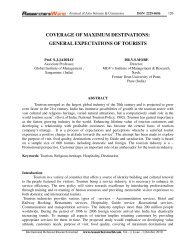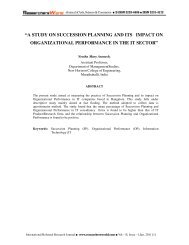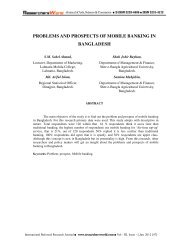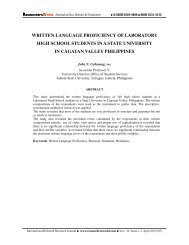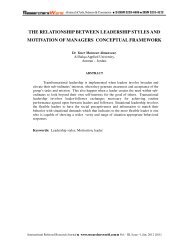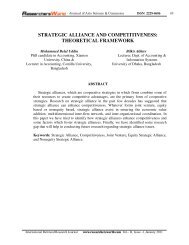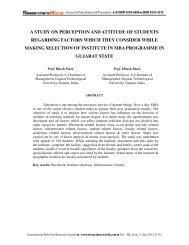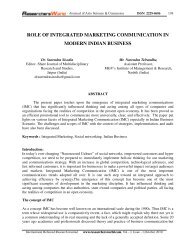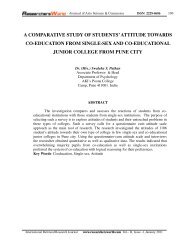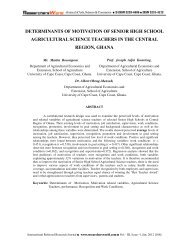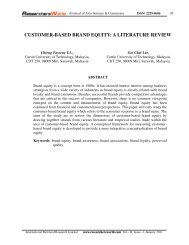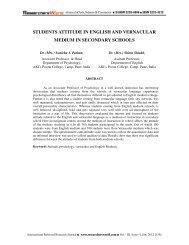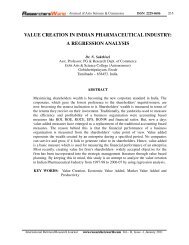settlement patterns and economic development - Researchers World
settlement patterns and economic development - Researchers World
settlement patterns and economic development - Researchers World
You also want an ePaper? Increase the reach of your titles
YUMPU automatically turns print PDFs into web optimized ePapers that Google loves.
-Journal of Arts, Science & Commerce ■ E-ISSN 2229-4686 ■ ISSN 2231-4172<br />
The indigene communities exhibit semblance of the culture of dependence<br />
The settler communities demonstrate a higher sense of self-help. Leadership attributes were<br />
found to influence both the direction <strong>and</strong> the pace of <strong>development</strong> that generates social<br />
change in the communities.<br />
Mixed communities mirror negative <strong>development</strong> aspirations due to poor inter-personal<br />
relations, which negatively impact on their community <strong>development</strong>.<br />
Politicisation of <strong>development</strong> resource allocations compromised equity in meeting the<br />
<strong>development</strong> needs of the communities.<br />
POLICY IMPLICATIONS AND CONCLUSION:<br />
This study examined the relationship between <strong>settlement</strong>s <strong>patterns</strong> <strong>and</strong> <strong>economic</strong> <strong>development</strong><br />
in the context of six communities in the central region of Ghana. The results of the study indicate that<br />
the indigene-settler divide is not a myth. Consequently, there is the need to underst<strong>and</strong> not only the<br />
challenges this reality presents, but more importantly how to overcome these challenges to promote<br />
<strong>economic</strong> <strong>development</strong>. This study has identified leading <strong>and</strong> lagging communities in respect of<br />
<strong>development</strong>. While settler communities appear more proactive in initiating self-help projects <strong>and</strong><br />
attracting NGOs to assist them, the picture is different in the indigene <strong>and</strong> mixed communities who<br />
rely almost entirely on the Central Government to initiate projects. Additionally, the mixed<br />
communities were found to be encumbered with disharmony which undermines community efforts at<br />
<strong>development</strong>.<br />
The findings of the study <strong>and</strong> the literature reviewed provide the following recommendations.<br />
First, the results show that the rural community members are unlikely to ab<strong>and</strong>on farming completely.<br />
The implication is that there is the need to establish the necessary linkages between non-farm <strong>and</strong><br />
farm activities to improve the overall productivity of the rural economy. Obviously, the agricultural<br />
sector has played a role in providing rural employment but it has been contending with other factors<br />
that limit its further potential for generating new jobs in most developing countries (Onchan, 2004).<br />
Thompson (2001) <strong>and</strong> Islam (1997) have all argued that <strong>economic</strong> <strong>development</strong> is associated with<br />
shifts from agricultural to a more diversified rural economy.<br />
Second, a workable national policy on l<strong>and</strong> tenure system is required to make l<strong>and</strong> tenure less<br />
cumbersome <strong>and</strong> give tenant farmers some security. Across the country, l<strong>and</strong> is either vested in stools<br />
or owned by family or private individuals. In rural areas like the sample communities, contractual<br />
agreements relating to l<strong>and</strong> use either through sale or lease, is not properly documented <strong>and</strong> therefore<br />
most l<strong>and</strong> owners abuse the privileges they have by<br />
exploiting those with whom they enter into tenure agreement. Third, a key issue is the need for<br />
serious effort at regional integration as the labour mobility in the region is one of the highest in the<br />
world. Konseiga (2005) has noted that inter-regional mobility remains the most efficient mechanism<br />
to reduce inequalities <strong>and</strong> foster <strong>economic</strong> growth.<br />
Fourth, Development agencies must endeavour to promote community ownership of<br />
<strong>development</strong> through conscious effort to solicit inputs from <strong>and</strong> active participation of the beneficiary<br />
community members throughout the project cycle. The <strong>development</strong> story belongs to the community<br />
<strong>and</strong> therefore their participation is a pre-requisite for sustainability <strong>development</strong>. This could be<br />
enhanced by the design of inventories of capacities <strong>and</strong> skills gaps of community leadership <strong>and</strong><br />
introduce appropriate training programs to make leadership more functional in the <strong>development</strong><br />
process.<br />
The implications of the study provide some directions for future research, including the need<br />
to underst<strong>and</strong> the l<strong>and</strong> problem <strong>and</strong> how government can intervene to make the relationship indigene<br />
<strong>and</strong> settlers less confrontational. The importance of the rural non-farm activities to the communities<br />
International Refereed Research Journal ■ www.researchersworld.com ■ Vol.– II, Issue –2,April 2011 213



